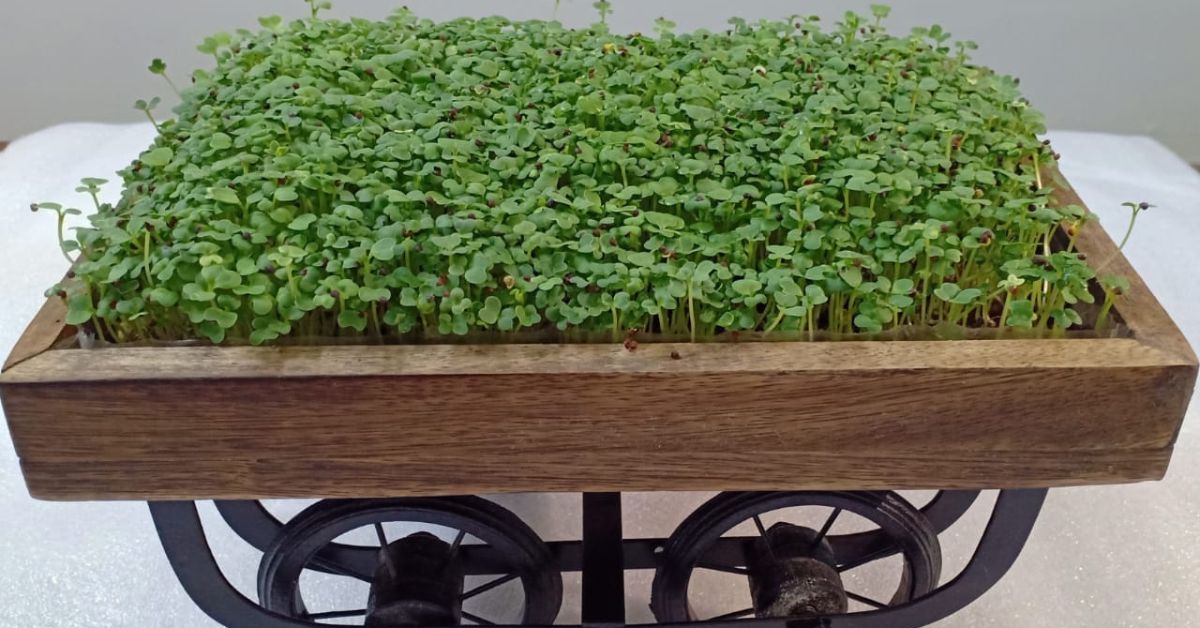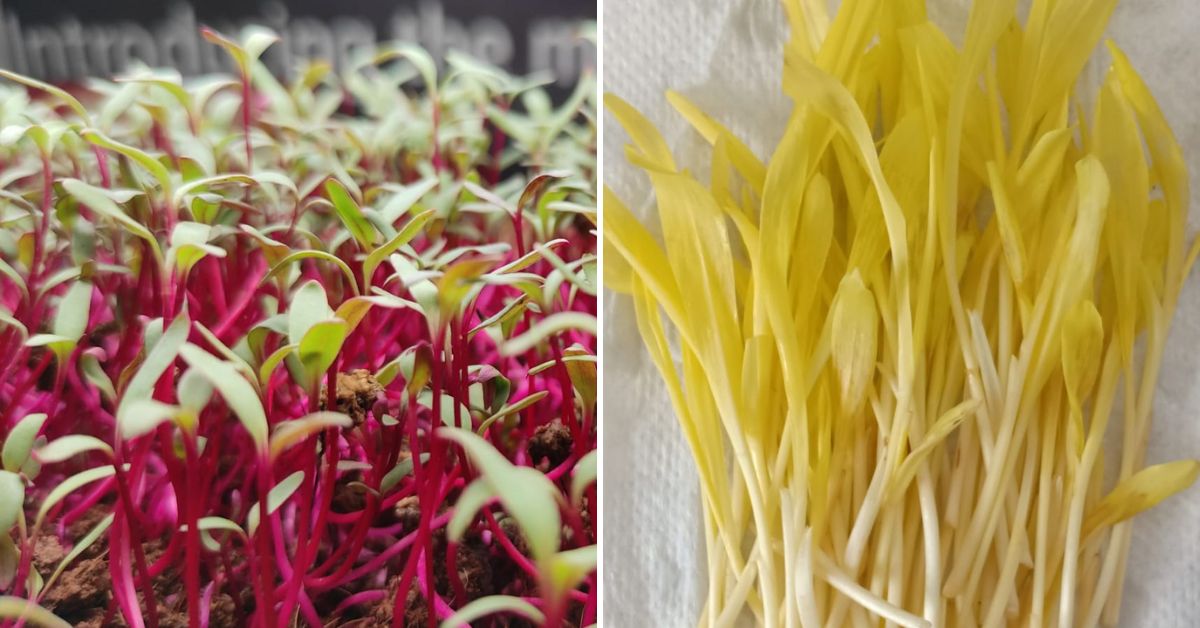How I Grow Microgreens in My Room & Earn Rs 3 Lakh/Month: Kerala Man Shares Tips
Kerala resident Ajay Gopinath shares how he grows microgreens in a small room in his house and has made a successful business out of growing the superfood.

Packed with nutrients, microgreens are often termed as a superfood. These are seedlings of vegetables or herbs in their initial stages of growth, and are in fact more nutritious than a fully grown vegetable.
All of this was new information to former bank employee Ajay Gopinath, who happened to find these tiny greens on his plate while dining at a restaurant in Bengaluru. Intrigued, he began research into what these were, and learned that they were not merely seasoning, but also highly nutritious.
Later, when Ajay quit his banking job to move back home to Kochi, he decided to try his luck with growing microgreens.
“Around 2017-2018, I started growing them on a small scale on an experimental basis. Though I wasn’t sure about the right methods, I eventually figured it out after two years of research and experimentation. Then I started growing them commercially,” says the 50-year-old.
Cut to 2022 — Ajay grows around 15 varieties of microgreens in an 80 sq-ft room in his house. He harvests around 5 kg of greens every day, and sees sales worth Rs 2 to 3 lakh per month.
A viable business

Ajay started out his journey with microgreens by watching YouTube tutorials. “I experimented with growing microgreens from green gram using tissue papers. But the result wasn’t as good as I expected. This made me realise that the tutorials were mostly fake and did not demonstrate the right way to cultivate microgreens,” he explains.
He widened his search for a viable procedure. Through a friend in the UK, he connected with a microgreens expert there. “He was a farmer growing microgreens and he enlightened me in this regard. He told me that not all seeds can be microgreens,” he says. “These are only Non-Genetically Modified Organism (GMO), non-hybrid, non-treated and open-pollinated seeds.”
Interacting with him made Ajay understand that there was a lot more to growing microgreens than what he saw online. He began sourcing seeds from Bengaluru, Pune, and Chattisgarh. “The seeds are bought at around Rs 600 per kg. Though it is expensive, when it comes to the yield, one could reap three times the amount spent on the seeds,” he points out.
It took him around two years to come up with a successful method of growing the greens within his house under controlled conditions.

“I started with two trays of microgreens and never expected to expand commercially. But once I distributed them among my friends, the response was very positive. They all were happy with the taste and quality. That’s when I realised its potential to be a viable business,” says Ajay, who expanded it into a business in 2020.
Almost three years into microgreens farming, he has so far tried around 30 varieties. “Around 150 varieties of microgreens are now available in the world, among which I am currently growing 15 varieties,” he adds.
Some varieties he grows at home are radish varieties like sango purple, china rose, red, and white, green mustard, yellow American mustard, beet, bok choy, corn, sunflower, etc.
“Radish, mustard, and sunflower are the best-selling varieties,” he says, adding that sunflower microgreens are the most nutritious of the lot.
How to grow microgreens

Ajay grows his microgreens in a bedroom at his house in Chittoor. The room has an area of 80 sqft and is always maintained at a temperature below 25 degrees and humidity at 40 to 60 per cent.
“One of the best mediums to grow high-quality microgreens is low EC cocopeat medium,” says Ajay, who grows them in the same cocopeat medium placed inside food-grade trays with holes.
Once the seeds are distributed onto the medium, they are closed and kept under dim light with good air circulation. After two days, when they germinate, they are kept open under certain light settings for proper growth.
It takes around seven days for the seeds to grow into microgreens, which will have a thin stem with a pair of leaves. As soon as the cotyledon leaves are out, they need to be harvested by cutting above the roots,” he explains.
Ajay says that only the stems and leaves of microgreens are to be consumed, and only in raw form. “There is often confusion about whether it needs to be cooked. But they shouldn’t be, as it would lose their nutritional value. They are best to be used as a healthy nutritional supplement and can be consumed as is or in dishes like salads,” he explains.
Ajay, who harvests around 5 kg of microgreens every day, sells them for Rs 150 per 100 gm and in bulk under his brand name Grow Greens. He also has franchises across Kerala, as well as in cities like Chennai and Bengaluru.

“Currently, I am supplying them to around 20-25 different channels of customers such as hotels, gyms, hospitals, and so on. Even celebrities buy greens from me,” he adds.
According to him, “Microgreens of a vegetable or plant hold many more nutrients than a full-grown plant. For example, 25 gm of red-cabbage microgreens have a nutritious value equal to consuming 1 kg of red cabbage.”
Studies also stated that they are a good source of nutrients like Vitamin C, Vitamin K, Vitamin B 12 etc. Most greens are also rich in minerals like potassium, iron, zinc, magnesium, and copper. Besides, they are packed with several antioxidants.
Ajay says that people are still unaware of the true potential of microgreens. “They are often considered sophisticated ingredients only available in five-star restaurants. But people must understand that it isn’t expensive or hard to nurture them. More people need to venture into microgreens farming and increase its availability, thereby spreading awareness about how good they are for everyone,” he adds.
For more information and enquiries, you can contact Ajay at 73062 99044.
Edited by Divya Sethu; Photo credits: Ajay Gopinath
This story made me
- 97
- 121
- 89
- 167
Tell Us More
We bring stories straight from the heart of India, to inspire millions and create a wave of impact. Our positive movement is growing bigger everyday, and we would love for you to join it.
Please contribute whatever you can, every little penny helps our team in bringing you more stories that support dreams and spread hope.



















